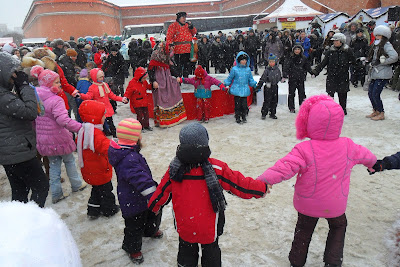
Every year, a week before Lent, Russia celebrates an old holiday that has its roots in Pagan and Christian traditions. In fact, it is the oldest holiday Russians celebrate. By this time in the year, meat is already forbidden to Orthodox Christians. Maslenitsa is the last week that cheese, milk, and other dairy products are permitted before Lent. Linguistically, the word is based on the Russian word for butter: Maclo(phonetically, the "c" is like an "s"). It literally means "butter week."

As in most European civilizations, Russia gathered and assimilated the beliefs and pagan traditions with its Christian equivalents, which were imported from the Byzantine Empire in the 10th century.
After the long winter, when the first signs of thawing were felt, the northern tribes coming out of their lethargy prepared a feast in honor of the Blazing Sun. Pancakes as round and golden as suns, made with mixed flours, were cooked and offered to Sun God for him not to forget to warm Mother Earth. This would in turn make the next harvest sprout. These pancakes (blini) were then eaten with butter, dried fish and meat. According to historians and archaeologists, the tribes celebrated a sort of costume party where the burning of an effigy of the Prince of Winter took place.
In the Christianized Russia, this feast was moved to the beginning of Lent (...) Blinis are served with smoked herring or caviar, but never meat.
-from Tatiana Maslenikoff's book La cocina rusa
I spent the morning of "Fat Thursday" making lots of blini for everyone, including a Russian guest, who enjoyed many servings---which is a very big compliment :D I've looked at a lot of recipes and I tell you it can be quite simple and pleasing for all:
1. Take three eggs and beat them with a tablespoon of sugar and a teaspoon of salt
2. Add a couple cups of milk
3. Add about a cup of flour and a dollop of oil
(It may become the lumpiest mess ever but KEEP STIRRING. It should be fairly runny---a bit more than American pancake batter.)
4. Then, fry 'em up in some oil! But remember the advice of Russian grandmothers everywhere: “Первый блин всегда комом.” It means, literaly, “the first blin always lumps up;” but is used in the context of “if at first you don’t succeed…”
5.Serve with jam, butter, or sweetened condensed milk--->YUM
Sunday is the largest part of the Maslenitsa week. Known as "Forgiveness Sunday," it is also a day of celebration. Across Russia, towns and cities gather in their centers for music, dancing, dogsledding, games, to buy and sell goods, and much much more. Following more pagan traditions, a large "Lady Maslenitsa" made of wheat, which represents winter, is burned to represent the passing of time, winter, sins, and so on. Blini are heavily eaten during this week because they represent the sun and include rich dairy products of milk, egg, and butter.
The Maslenitsa fair in St. Petersburg was incredible, to say the least. The day was frigid cold though. Snowing almost all day, we shuffled over a thick layer of ice and snow all the day long, suffering from frightfully cold toes. Approaching the fair was almost surreal because one could hear the sounds of old Russian songs, which only provincial towns or Old Believer colonies still practice. It seemed so strangely out of place in the urban setting of St. Petersburg.
The fair was located behind the Peter and Paul Fortress, which houses a number of museums and the famed Peter and Paul Cathedral, where almost all the emperors and empresses from Peter the Great to Nicholas II are laid to rest.




There was a HUGE ice slide for adults. One could rent a tube for 100 rubles($3) and a deposit of ID. We explored for quite a long time before venturing into the long, cold line for the slide.
We watched dancers.




We saw women and children with straw dolls.

We saw children rolled in giant, clear spheres.


We saw games, games, games.


We danced.

We ate hot corn that instantly became cold in the frigid wind. Some of us pet owls. We saw dogsledding. I saw a large trained raven do tricks and shopped for spices. There was honey from the Altai region, known to be some of the best honey in the world. There were homemade jams from berries I've never heard of and dried mushrooms from last summer's season.
Eventually, we did, indeed, slide!


People were joyous. It was just as joyous as any painting I have ever seen of the provincial towns.
Boris Kustodiev painted these in the early 20th century:




He was a highly popular artist, even after the revolution, because his paintings depicted such exaggerated joy. His father died when he was just a boy, forcing the family to move to a provincial town. This heavily influenced all of his works. After becoming paraplegic at the age of 38, he painted some of his most famous works, focusing on the memories of his childhood to inspire him.
In 1978, his works were put onto postal stamps.

(See the one with the woman eating lunch next to the cat? A nice luscious meal. A sunny, warm day. Luxury.)
Other painters have painted about Maslenitsa as well:
Vladimir Makovsky:

Aleksandr Viktorovich Shevelev


Later in the day, we went to a cafe for a while to "thaw out," so to speak. In the evening, snowboarders played on the giant slide for a while until it was time for the final act of Maslenitsa: the burning of Lady Maslenitsa! In provincial towns, this still happens, but in the urban setting of St. Petersburg, the giant slide represented the big Lady. She shot out a mass of fireworks and smoke for a quite a beautiful time, while characters from throughout the day sled down the slide.



No comments:
Post a Comment